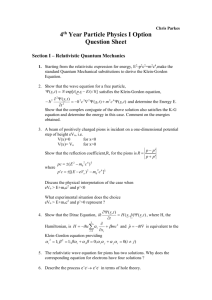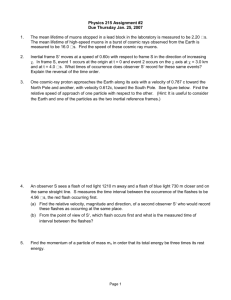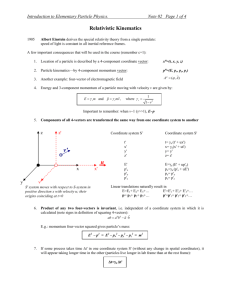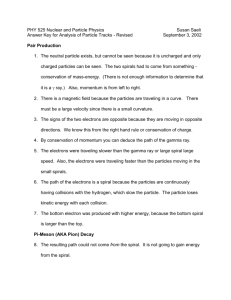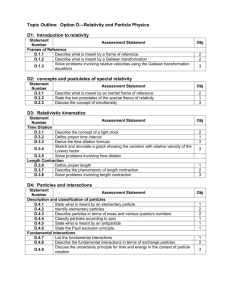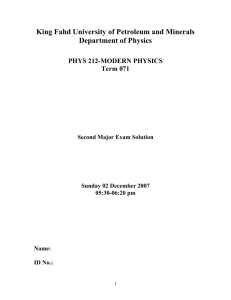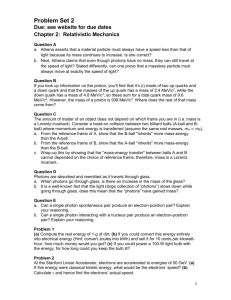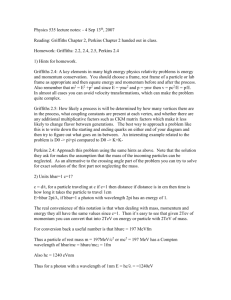Question Sheet - University of Manchester
advertisement
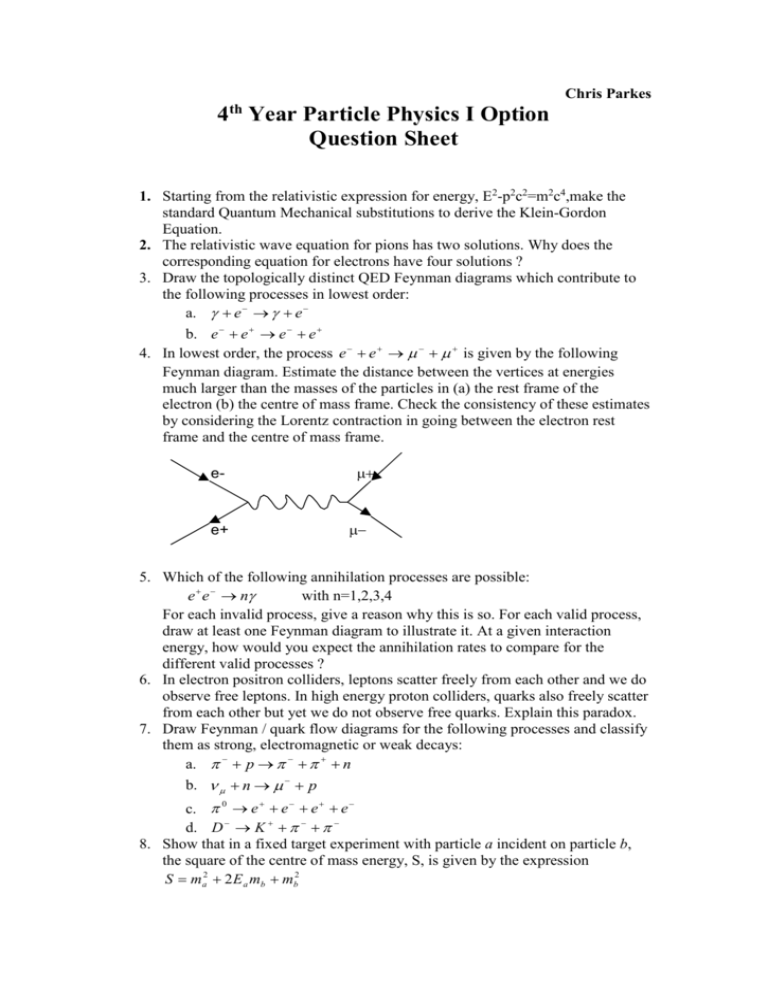
Chris Parkes
4th Year Particle Physics I Option
Question Sheet
1. Starting from the relativistic expression for energy, E2-p2c2=m2c4,make the
standard Quantum Mechanical substitutions to derive the Klein-Gordon
Equation.
2. The relativistic wave equation for pions has two solutions. Why does the
corresponding equation for electrons have four solutions ?
3. Draw the topologically distinct QED Feynman diagrams which contribute to
the following processes in lowest order:
a. e e
b. e e e e
4. In lowest order, the process e e is given by the following
Feynman diagram. Estimate the distance between the vertices at energies
much larger than the masses of the particles in (a) the rest frame of the
electron (b) the centre of mass frame. Check the consistency of these estimates
by considering the Lorentz contraction in going between the electron rest
frame and the centre of mass frame.
e-
e+
5. Which of the following annihilation processes are possible:
with n=1,2,3,4
e e n
For each invalid process, give a reason why this is so. For each valid process,
draw at least one Feynman diagram to illustrate it. At a given interaction
energy, how would you expect the annihilation rates to compare for the
different valid processes ?
6. In electron positron colliders, leptons scatter freely from each other and we do
observe free leptons. In high energy proton colliders, quarks also freely scatter
from each other but yet we do not observe free quarks. Explain this paradox.
7. Draw Feynman / quark flow diagrams for the following processes and classify
them as strong, electromagnetic or weak decays:
a. p n
b. n p
c. 0 e e e e
d. D K
8. Show that in a fixed target experiment with particle a incident on particle b,
the square of the centre of mass energy, S, is given by the expression
S ma2 2 E a mb mb2
9. In a colliding beam experiment, particles a and b, of same mass and equal but
opposite momenta interact to give particles c and d. Show that the centre of
momentum of particle c, p c* , is given by the expression
1
p c* p d* {[W 2 (mc md ) 2 ][W 2 (mc md ) 2 ]} 2 / 2W and that the total
energy of particle c is given by E c* (W 2 mc2 md2 ) / 2W where W is the
total centre of mass energy. What is the corresponding expression for the
centre of mass energy of particle d?
10. Show that the invariant mass of a pair of photons of energies, E1 , E2 with
angle between their directions is given by the expression
m 2 4 E1 E2 sin 2 ( / 2) . Consider the decay of a particle of mass m energy E
into 2 photons, and show that the minimum opening angle between the
photons is given by sin( / 2) m / E . A particle of energy 10 GeV decays to
two photons with opening angle 2. Could this particle be an meson (of
mass 0.549 GeV) or a meson (of mass 0.135 GeV)?
11. Define four momentum transfer. In an elastic scattering experiment, particle a
is scattered through an angle * in the centre of mass system. Show that the
four momentum transfer, q, is given by the expression q 2 2 p *2 (1 cos * ) ,
where p* is the centre of mass momentum of a. Show that in the limit that the
masses of the particles may be neglected, q is proportional to the total centre
of mass energy.
12. a) The experimental cross section for e e in a colliding ring
experiment at high energy can be fitted to the equation
d
2
(
)(1 cos 2 * ) where d * is an element of solid angle into which
*
2
d
16 E
the - emerges, * is the angle the - makes with the incident e- and E is the
energy of the particles in each beam. Show that the total cross section, , is
4 2
given by
where S Ecm and is the fine structure constant.
3S
b) Calculate the total cross section for e e at CM energies of 2
GeV and 40 GeV. What are the corresponding cross-sections for
e e ? The masses of the electron, muon and tau lepton are 0.511
MeV, 105.6 MeV and 1777 MeV respectively.
13. In a colliding beam experiment, define luminosity and explain how it is related
to the interaction rate. Obtain an expression for luminosity in terms of the
design features of an accelerator and discuss how the features can be
optimised to improve overall performance.
14. How much energy was lost per turn due to synchrotron radiation for a 100
GeV beam at the LEP2 accelerator ? Discuss why an electron-positron
machine with a centre-of-mass energy of 1TeV is likely to be built as a Linac.
15. Draw the lowest order Feynman diagrams for neutrino electron scattering,
hence showing that both charged and neutral current interactions contribute.
16. a) Identify the dominant decay mode of a Higgs boson of mass approximately
the same as the Z boson. b) What will be the dominant leptonic decay ?
estimate the approximate ratio of decays to the states you identified in a) and
b).
17. In our discussion of reactions such as e e , we neglected the
contribution from the Higgs exchange diagram. Justify this assumption.
18. Show that the generator matrices of SU(2) obey the relations
1 0
1 2 2 2 3 2
0 1
1 2 2 1 i 3 , etc
and show that the combinations
12 ( 1 i 2 )
12 ( 1 i 2 )
can be said to act as “raising” and “lowering” operators of weak isospin.
